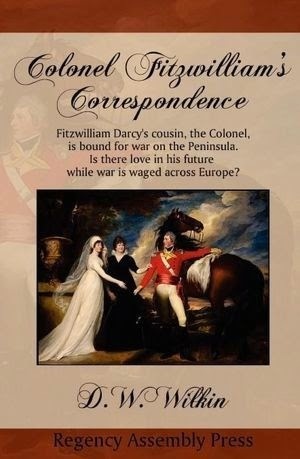D.W. Wilkin's Blog, page 164
December 18, 2014
A Trolling we Will Go Omnibus: The first three Fantasy stories of Humphrey and Gwendolyn
A Trolling We Will Go Omnibus:The Early Years Not only do I write Regency and Romance, but I also have delved into Fantasy.
The Trolling series, (the first three are in print) is the story of a man, Humphrey. We meet him as he has left youth and become a man with a man’s responsibilities.
We follow him in a series of stories that encompass the stages of life. We see him when he starts his family, when he has older sons and the father son dynamic is tested.
We see him when his children begin to marry and have children, and at the end of his life when those he has loved, and those who were his friends proceed him over the threshold into death.
All this while he serves a kingdom troubled by monsters. Troubles that he and his friends will learn to deal with and rectify.
Here are the first three books together as one longer novel.
A Trolling We Will Go, Trolling Down to Old Mah Wee and Trolling’s Pass and Present.
Available in a variety of formats.
For $6.99 you can get this fantasy adventure.
Barnes and Noble for your Nook
The stories of Humphrey and Gwendolyn. Published separately in: A Trolling we Will Go, Trolling Down to Old Mah Wee and Trollings Pass and Present.
These are the tales of how a simple Woodcutter and an overly educated girl help save the kingdom without a king from an ancient evil. Long forgotten is the way to fight the Trolls.
Beasts that breed faster than rabbits it seems, and when they decide to migrate to the lands of humans, their seeming invulnerability spell doom for all in the kingdom of Torahn. Not only Torahn but all the human kingdoms that border the great mountains that divide the continent.
Feedback
If you have any commentary, thoughts, ideas about the book (especially if you buy it, read it and like it ;-) then we would love to hear from you.

December 17, 2014
Regency Personalities Series-Sir Charles Fellows
Regency Personalities Series
In my attempts to provide us with the details of the Regency, today I continue with one of the many period notables.
Sir Charles Fellows
August, 1799 – 8 November 1860
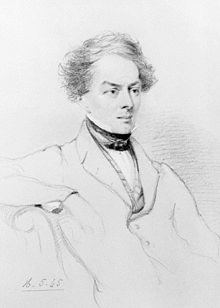
Charles Fellows
Sir Charles Fellows was born at Nottingham, where his family had an estate. When fourteen he drew sketches to illustrate a trip to the ruins of Newstead Abbey, which afterwards appeared on the title-page of Moore’s Life of Lord Byron. In 1820 he settled in London, where he became an active member of the British Association. In 1827 he discovered the modern ascent of Mont Blanc. After the death of his mother in 1832 he passed the greater portion of his time in Italy, Greece and the Levant. The numerous sketches he executed were largely used in illustrating Childe Harold.
In 1838 he went to Asia Minor, making Smyrna his headquarters. His explorations in the interior and the south led him to districts practically unknown to Europeans, and he thus discovered ruins of a number of ancient cities. He entered Lycia and explored the Xanthus from the mouth at Patara upwards. Nine miles from Patara he discovered the ruins of Xanthus, the ancient capital of Lycia, finely situated on hills, and abounding in magnificent remains. About 15 miles farther up he came upon the ruins of Tlos. After taking sketches of the most interesting objects and copying a number of inscriptions, he returned to Smyrna through Caria and Lydia. The publication in 1839 of A Journal written during an Excursion in Asia Minor roused such interest that Lord Palmerston, at the request of the British Museum authorities, asked the British consul at Constantinople to get leave from the sultan to ship a number of the Lycian works of art.
Late in 1839 Fellows, under the auspices of the British Museum, again set out for Lycia, accompanied by George Scharf, who assisted him in sketching. This second visit resulted in the discovery of thirteen ancient cities, and in 1841 appeared An Account of Discoveries in Lycia, being a Journal kept during a Second Excursion in Asia Minor. A third visit was made late in 1841.
In 1844 he presented to the British Museum his portfolios, accounts of his expeditions, and specimens of natural history illustrative of Lycia. In 1845 he was knighted as an acknowledgment of his services in the removal of the Xanthian antiquities to this country. He paid his own expenses in all his journeys and received no public reward.
Fellows was married twice. He died in London in 1860.
In addition to the works above mentioned, Fellows published the following:
The Xanthian Marbles; their Acquisition and Transmission to England (1843), a refutation of false statements that had been published;
An Account of the Ionic Trophy Monument excavated at Xanthus (1848);
a cheap edition of his two Journals, entitled
Travels and Researches in Asia Minor, particularly in the Province of Lycia (1852);
Coins of Ancient Lycia before the Reign of Alexander; with an Essay on the Relative Dates of the Lycian Monuments in the British Museum (1855).

A Jane Austen Sequel: Colonel Fitzwilliam’s Correspondence
Colonel Fitzwilliam’s Correspondence For your enjoyment, one of the Regency Romances I published.
It is available for sale and I hope that you will take the opportunity to order your copy.
For yourself or as a gift. It is now available in a variety of formats.
For just a few dollars this Regency Romance can be yours for your eReaders or physically in Trade Paperback.
Visit the dedicated Website
Barnes and Noble for your Nook or in Paperback
Amazon for your Kindle or in Trade Paperback
Witnessing his cousin marry for love and not money, as he felt destined to do, Colonel Fitzwilliam refused to himself to be jealous. He did not expect his acquaintance with the Bennet Clan to change that.
Catherine Bennet, often called Kitty, had not given a great deal of thought to how her life might change with her sisters Elizabeth and Jane becoming wed to rich and connected men. Certainly meeting Darcy’s handsome cousin, a Colonel, did not affect her.
But one had to admit that the connections of the Bingleys and Darcys were quite advantageous. All sorts of men desired introductions now that she had such wealthy new brothers.
Kitty knew that Lydia may have thought herself fortunate when she had married Wickham, the first Bennet daughter to wed. Kitty, though, knew that true fortune had come to her. She just wasn’t sure how best to apply herself.
Feedback
If you have any commentary, thoughts, ideas about the book (especially if you buy it, read it and like it ;-) then we would love to hear from you.

December 16, 2014
Regency Personalities Series-General Sir William Francis Patrick Napier
Regency Personalities Series
In my attempts to provide us with the details of the Regency, today I continue with one of the many period notables.
General Sir William Francis Patrick Napier
7 December 1785– 12 February 1860
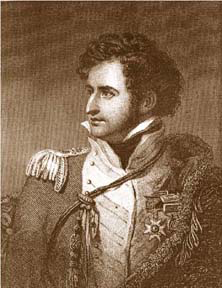
William Francis Patrick Napier
General Sir William Francis Patrick Napier became an ensign in the Royal Irish Artillery in 1800, but at once exchanged into the 62nd, and was put on half-pay in 1802. He was afterwards made a cornet in the Royal Horse Guards by the influence of his uncle the duke of Richmond, and for the first time did actual military duty in this regiment, but he soon fell in with Sir John Moore’ssuggestion that he should exchange into the 52nd, which was about to be trained at Shorncliffe Army Camp. Through Sir John Moore he soon obtained a company in the 43rd, joined that regiment at Shorncliffe and became a great favourite with Moore.
He served in Denmark, and was present at the engagement of Koege (Køge), and, his regiment being shortly afterwards sent to Spain, he bore himself nobly through the retreat to Corunna, the hardships of which permanently impaired his health. In 1809 he became aide-de-camp to his cousin the Duke of Richmond, Lord Lieutenant of Ireland, but joined the 43rd when that regiment was ordered again to Spain. With the light brigade (the 43rd, 52nd, and 95th), under the command of General Craufurd, he marched to Talavera in the famous forced march which he has described in his History, and had a violent attack of pleurisy on the way.
He, however, refused to leave Spain, was wounded on the Coa, and shot near the spine at Cazal Nova. His conduct was so conspicuous during the pursuit of Masséna after he left the lines of Torres Vedras that he as well as his brother George was recommended for a brevet majority. He became Brigade Major, was present at Fuentes d’Onoro, but had so bad an attack of ague that he was obliged to return to England.
In England he married his cousin Caroline Amelia Fox, daughter of General, the Honourable Henry Fox and niece of the statesman Charles James Fox. They had a number of children, one of whom, Pamela Adelaide Napier, married Philip William Skynner Miles and had a son, Philip Napier Miles. Another daughter, Louisa Augusta Napier, married General Sir Patrick Leonard MacDougall who, after her death, married Marianne Adelaide Miles, a sister of Philip William Skynner Miles.
Three weeks after his marriage he again started for Spain, and was present at the storming of Badajoz, where his great friend Colonel McLeod was killed. In the absence of the new Lieutenant-Colonel he took command of the 43rd regiment (he was now a substantive Major) and commanded it at the battle of Salamanca. After a short stay at home he again joined his regiment at the Pyrenees, and did his greatest military service at the Battle of Nivelle, where, with instinctive military insight, he secured the most strongly fortified part of Soult’s position, practically without orders. He served with his regiment at the battles of the Nive, where he received two wounds, Orthes, and Toulouse. For his services he was made brevet Lieutenant-Colonel, and one of the first C.B.s. Like his brother Charles he then entered the military college at Farnham. He commanded his regiment in the invasion of France after Waterloo, and remained in France with the army of occupation until 1819, when he retired on half-pay. As it was impossible for him to live on a Major’s half-pay with a wife and family, he determined to become an artist, and took a house in Sloane Street, where he studied with George Jones, the academician.
The years he had spent in France he had occupied in improving his general education, for, incredible as it seems, the author of the History of the War in the Peninsula could not spell or write respectable English till that time. But his career was to be great in literature, not in art. The tendency appeared in an able review of Jomini’s works (Edinburgh Review) in 1821, and in 1823 Henry Bickersteth suggested that he write a history of the Peninsular War.
For some time he did not take kindly to the suggestion, but at last determined to become an author in order to defend the memory of Sir John Moore, and to prevent the glory of his old chief being overshadowed by that of Wellington. The Duke of Wellington himself gave him much assistance, and handed over to him the whole of Joseph Bonaparte’s correspondence which had been taken at the battle of Vittoria; this was all in cipher, but Mrs Napier, with great patience, discovered the keys. Marshal Soult also took an active interest in the work and arranged for the French translation of Mathieu Dumas.
In 1828 the first volume of the History appeared. The publisher, John Murray, indeed, was disappointed in the sale of the first volume and Napier published the remainder himself. But it was at once seen that the great deeds of the Peninsular War were about to be fitly commemorated. The excitement which followed the appearance of each volume is proved by the innumerable pamphlets issued by those who believed themselves to be attacked, and by personal altercations with many distinguished officers. But the success of the book was proved still more by the absence of competition than by these bitter controversies. The histories of Southey and Lord Londonderry fell still-born, and Sir George Murray, Wellington’s quartermaster-general, who had determined to produce the history, gave up the attempt in despair. This success was due to a combination of qualities which have justly secured for Napier the title of being the greatest military historian England has produced. When in 1840 the last volume of the History was published, his fame not only in England but in France and Germany was safely established.
His life during these years had been chiefly absorbed in his History, but he had warmly sympathized with the movement for political reform which was agitating England. ‘The Radicals’ of Bath, (forerunners of Chartism), and many other cities and towns pressed him to enter parliament, and Napier was actually invited to become tile military chief of a national guard to obtain reforms by force of arms. He refused the dangerous honor on the ground that he was in bad health and had a family of eight children. In 1830 he had been promoted Colonel, and in 1841 he was made a Major-General and was appointed Lieutenant Governor of Guernsey. Here he found plenty of occupation in controlling the relations between the soldiers and the inhabitants, and also in working out proposals for a complete scheme of reform in the government of the island.
While he was at Guernsey his brother Charles had conquered Sindh, and the attacks made on the policy of that conquest brought William Napier again into the field of literature. In 1845 he published his History of the Conquest of Scinde, and in 1851 the corresponding History of the Administration of Scinde books which in style and vigour rivalled the great History, but which, being written for controversial purposes, were not likely to maintain enduring popularity. In 1847 he resigned his governorship, and in 1848 was made a K.C.B., and settled at Scinde House, Clapham Park. In 1851 he was promoted Lieutenant-General. His time was fully occupied in defending his brother, in revising the numerous editions of his History which were being called for, and in writing letters to The Times on every conceivable subject, whether military or literary. His energy is the more astonishing when it is remembered that he never recovered from the effects of the wound he had received at Cazal Nova, and that he often had to lie on his back for months together.
His domestic life was shadowed by the incurable affliction of his only son, and when his brother Charles died in 1853 the world seemed to be darkening round him. He devoted himself to writing the life of that brother, which appeared in 1857, and which is in many respects his most characteristic book. In the end of 1853 his younger brother, Captain Henry Napier, RN., died, and in 1855 his brother Sir George. Inspired by his work, he lived on till the year 1860, when, broken by trouble, fatigue and ill-health, he died at Clapham, and was buried at West Norwood. Four months earlier he had been promoted to the full rank of general.

Space Opera Books presents ECO Agents:Save The Planet a Young Adult Adventure
First ECO Agents book available
Those who follow me for a long time know that I also write in other fields aside from Regency Romance and the historical novels I do.
A few months ago, before the end of last year and after 2011 NaNoWriMo, (where I wrote the first draft of another Regency) I started work on a project with my younger brother Douglas (All three of my brothers are younger brothers.)
The premise, as he is now an educator but once was a full on scientist at the NHI and FBI (Very cloak and dagger chemistry.) was that with the world having become green, and more green aware every week, why not have a group of prodigies, studying at a higher learning educational facility tackle the ills that have now begun to beset the world.
So it is now released. We are trickling it out to the major online channels and through Amazon it will be available in trade paperback. Available at Amazon for your Kindle, or your Kindle apps and other online bookstores. For $5.99 you can get this collaboration between the brothers Wilkin. Or get it for every teenager you know who has access to a Kindle or other eReader.
Barnes and Noble for your Nook Smashwords iBookstore for your Apple iDevices Amazon for your Kindle
Five young people are all that stands between a better world and corporate destruction. Parker, Priya, JCubed, Guillermo and Jennifer are not just your average high school students. They are ECOAgents, trusted the world over with protecting the planet.
Our Earth is in trouble. Humanity has damaged our home. Billionaire scientist turned educator, Dr. Daniel Phillips-Lee, is using his vast resources to reverse this situation. Zedadiah Carter, leader of the Earth’s most powerful company, is only getting richer, harvesting resources, with the aid of not so trustworthy employees.
When the company threatens part of the world’s water supply, covering up their involvement is business as usual. The Ecological Conservation Organization’s Academy of Higher Learning and Scientific Achievement, or simply the ECO Academy, high in the hills of Malibu, California overlooking the Pacific Ocean, is the envy of educational institutions worldwide.
The teenage students of the ECO Academy, among the best and brightest the planet has to offer, have decided they cannot just watch the world self-destruct. They will meet this challenge head on as they begin to heal the planet.
Feedback
If you have any commentary, thoughts, ideas about the book (especially if you buy it, read it and like it ;-) then we would love to hear from you.

December 15, 2014
Regency Personalities Series-Sir Horace St Paul 1st Baronet of Ewart Park
Regency Personalities Series
In my attempts to provide us with the details of the Regency, today I continue with one of the many period notables.
Sir Horace St Paul 1st Baronet of Ewart Park
January 1775 – 8 October 1840
Sir Horace St Paul 1st Baronet was an English soldier and Member of Parliament.
He was born in Paris, the eldest son of Horace St. Paul of Ewart Park, Northumberland. His younger brother was Henry Heneage St Paul, MP for Berwick-upon-Tweed from 1812 to 1820.
St Paul was educated at Houghton le Spring and Eton College (1783). He succeeded his father in 1812 as a count of the Austrian Empire.
He joined the British Army as an ensign in the 1st Foot regiment in 1793, and was promoted to lieutenant in 1794. He transferred to the 1st Dragoon Guards as a cornet in March 1794, became a lieutenant in July 1794 and a captain in 1798. He was then a major in the 5th Foot in 1802, rising to brevet lieutenant-colonel in 1811, and to colonel (on half-pay) in 1820.
He was elected MP for Bridport in 1812, sitting until 1820, when he was beaten by Christopher Spurrier. However he regained the seat on petition and sat again until 1832. He was created a baronet on 17 November 1813.
He married Anna Maria, the heiress of John Ward, 2nd Viscount Dudley and Ward and had a son and 5 daughters. He was succeeded by his son Horace (1812–91), MP for Worcestershire East, who succeeded him as count and baronet.

Space Opera Books Presents A Trolling We Will Go Omnibus:The Latter Years
A Trolling We Will Go Omnibus:The Latter Years
Not only do I write Regency and Romance, but I also have delved into Fantasy.
The Trolling series, is the story of a man, Humphrey. We meet him as he has left youth and become a man with a man’s responsibilities. He is a woodcutter for a small village. It is a living, but it is not necessarily a great living. It does give him strength, muscles.
We follow him in a series of stories that encompass the stages of life. We see him when he starts his family, when he has older sons and the father son dynamic is tested.
We see him when his children begin to marry and have children, and at the end of his life when those he has loved, and those who were his friends proceed him over the threshold into death.
All this while he serves a kingdom troubled by monsters. Troubles that he and his friends will learn to deal with and rectify.
Here are the last two books together as one longer novel.
Trolling, Trolling, Trolling Fly Hides! and We’ll All Go a Trolling.
Available in a variety of formats.
For $5.99 you can get this fantasy adventure.
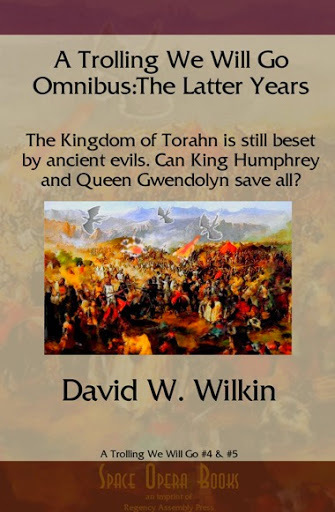
Barnes and Noble for your Nook
The stories of Humphrey and Gwendolyn. Published separately in: Trolling, Trolling, Trolling Fly Hides! and We’ll All Go a Trolling. These are the tales of how a simple Woodcutter who became a king and an overly educated girl who became his queen helped save the kingdom of Torahn from an ancient evil. Now with the aid of their children and their grandchildren.
Long forgotten is the way to fight the Trolls. Beasts that breed faster than rabbits it seems, and when they decide to migrate to the lands of humans, their seeming invulnerability spell doom for all in the kingdom of Torahn. Not only Torahn but all the human kingdoms that border the great mountains that divide the continent.
The Kingdom of Torahn has settled down to peace, but the many years of war to acheive that peace has seen to changes in the nearby Teantellen Mountains. Always when you think the Trolls have also sought peace, you are fooled for now, forced by Dragons at the highest peaks, the Trolls are marching again.
Now Humphrey is old, too old to lead and must pass these cares to his sons. Will they be as able as he always has been. He can advise, but he does not have the strength he used to have. Nor does Gwendolyn back in the Capital. Here are tales of how leaders we know and are familiar with must learn to trust the next generation to come.
Feedback
If you have any commentary, thoughts, ideas about the book (especially if you buy it, read it and like it ;-) then we would love to hear from you.

December 14, 2014
Regency Personalities Series-Sir Edward Codrington
Regency Personalities Series
In my attempts to provide us with the details of the Regency, today I continue with one of the many period notables.
Admiral Sir Edward Codrington
27 April 1770 – 28 April 1851
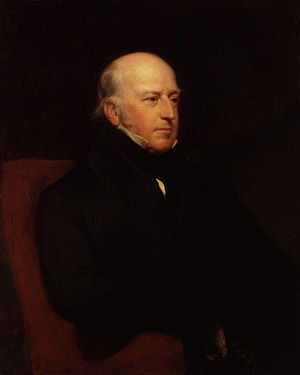
Edward Codrington
Sir Edward Codrington was the youngest of three brothers born to an aristocratic, landowning family, Codrington was educated by an uncle named Mr Bethell. He was sent for a short time to Harrow, and entered the Royal Navy in July 1783. He served off the Eastern Seaboard of the United States, in the Mediterranean and in home waters, until he was promoted to lieutenant on 28 May 1793, when Lord Howe selected him to be signal lieutenant on the flagship of the Channel fleet at the beginning of the French Revolutionary Wars. In that capacity he served on the 100-gun HMS Queen Charlotte during the operations which culminated in the battle of the Glorious First of June.
As a reward for his actions at the battle, on 7 October 1794 he was promoted to commander, and on 6 April 1795 attained the rank of Post-Captain and the command of the 22-gun HMS Babet from which he observed the Battle of Groix. His next command was the frigate HMS Druid whom he commanded in the Channel and off the coast of Portugal, until she was paid off in 1797. Following this, Codrington spent a period largely on land and on half-pay for some years. In December 1802 he married Jane Hall, an English woman from Kingston, Jamaica, and remained without a ship until the Peace of Amiens came to a close in 1803.
On the renewal of hostilities with France he remained in frigates for some time before being given the ship of the line HMS Orion in the spring of 1805 which was attached to Admiral Nelson’s fleet off Cadiz in the blockade of the combined fleet. Codrington and Orion were engaged at the Battle of Trafalgar on 21 October 1805, where Orion was stationed to the rear of the northern division and therefore took two hours to reach battle. Once there, Codrington ignored all other ships and focused entirely on closing with a hitherto unengaged French ship, the Swiftsure, forcing her to surrender. He then attacked but failed to capture the Spanish flagship Principe de Asturias before moving on to the Intrepide, the only ship of the northern division to return. Orion, with other ships, dismasted and then sailed round her, firing continually until she surrendered.
For the next several years, Codrington fought alongside the Spanish against the French in the Mediterranean Sea, commanding a squadron that harried French shipping and made numerous coastal raids. During this time also participated in the disastrous Walcheren expedition in 1809.
The two months of May and June in 1811 were to prove his most testing time whilst stationed on Spain’s eastern seaboard. He went to great lengths to help the Spanish besieged at Tarragona by the French Army of Aragon under Louis Gabriel Suchet.
Convinced that Lieutenant General Juan Senen de Contreras, the Spanish general in charge of Tarragona, wasn’t up to the task, Codrington, who had a clearer understanding of the situation, helped the British military agent Charles William Doyle to contrive a plan of succour. Through his own personal efforts Codrington brought to Tarragona 6,300 Spanish infantry and 291 artillerymen as reinforcements. He spent many nights in the port area guiding cannon launches against the enemy. When the city fell, he rescued over 600 people from the beach in a Dunkirk-style operation under fire from enemy cannon and personally undertook to reunite mothers and babies who had been separated during the evacuation. Afterwards, he intervened on a political level to stop Captain General de Lacy disarming the local Catalan Somaténs (militias).
Codrington was promoted to the rank of rear admiral (of the Blue) on 4 June 1814, while he was serving off the coast of North America as captain of the fleet to Vice Admiral Sir Alexander Cochrane during the operations against Washington, Baltimore and New Orleans during the War of 1812. In recognition of this service, in 1815 he was made a Knight Commander of the Bath. He became a rear admiral of the Red on 12 August 1819, and then a vice admiral on 10 July 1821. He was also elected a fellow of the Royal Society in February 1822.
In December 1826 Codrington was appointed Commander-in-Chief, Mediterranean Fleet and sailed on 1 February 1827. From that date until his recall on 21 June 1828 he was engaged in the arduous duties imposed on him by the Greek War of Independence, which had led to anarchy in occupied Greece and surrounding areas. His orders were to enforce a peaceful solution on the situation in Greece, but Codrington was unfortunately not known for his diplomacy, and on 20 October 1827 he destroyed the Turkish and Egyptian fleet at the Battle of Navarino while in command of a combined British, French and Russian fleet.
After the battle Codrington went to Malta to refit his ships. He remained there till May 1828, when he sailed to join his French and Russian colleagues on the coast of the Morea. They endeavoured to enforce the evacuation of the peninsula by Ibrahim Pasha peacefully. The Pasha made diplomatic difficulties,which came in the form of continuous genocide against the Greeks of Morea who were to be replaced with Muslims from Africa and on 25 July the three admirals agreed that Codrington should go to Alexandria to obtain Ibrahims recall by his father Mehemet Ali. Codrington had heard on 22 June of his own supersession, but, as his successor had not arrived, he carried out the arrangement made on 25 July, and his presence at Alexandria led to the treaty of the 6 August 1828, by which the evacuation of the Morea was settled. His services were recognised by the grant of the Grand Cross of the Bath, but there is no doubt that the British government was embarrassed by his heavy-handed gunboat diplomacy and not too impressed by the further weakening of Russia’s main opponent, the Ottomans.
After his return home Codrington spent some time in defending himself, and then in leisure abroad. He commanded a training squadron in the Channel in 1831 and became a full admiral on 10 January 1837. He was elected Member of Parliament for Devonport in 1832, and sat for that constituency until he accepted the Chiltern Hundreds in 1839. From November 1839 to December 1842 he was Commander-in-Chief, Portsmouth. Codrington died in London on 28 April 1851. He left two sons, both of whom achieved distinction in the British armed forces. Sir William John Codrington (1804–1884) was a commander in the Crimean War. Sir Henry Codrington (1808–1877), a naval officer, became an Admiral of the Fleet.
A third son, Edward Codrington, was a midshipman aboard Cambrian when he died sometime in 1821 or 1822 in the Mediterranean. He had been taking a cutter to Hydra when a squall overturned the boat, drowning him, a merchant, and three crewmen.
Codrington was buried in St Peter’s Church, Eaton Square.

An Unofficial Guide to how to win the Scenarios of Rollercoaster Tycoon 3
An Unofficial Guide to how to win the Scenarios of Rollercoaster Tycoon 3
I have been a fan of this series of computer games since early in its release of the very first game. That game was done by one programmer, Chris Sawyer, and it was the first I recall of an internet hit. Websites were put up in dedication to this game where people showed off their creations, based on real amusement parks. These sites were funded by individuals, an expense that was not necessarily as cheap then as it is now. Nor as easy to program then as it might be to build a web page now.
Prima Books released game guides for each iteration of the game, Rollercoaster Tycoon 1, Rollercoaster Tycoon 2 and Rollercoaster Tycoon 3 (RCT3) but not for the expansion sets. And unlike the first two works, the third guide was riddle with incorrect solutions. As I played the game that frustrated me. And I took to the forums that Atari, the game publisher hosted to see if I could find a way to solve those scenarios that the Prima Guide had written up in error. Not finding any good advice, I created my own for the scenarios that the “Official” Guide had gotten wrong.
Solutions that if you followed my advice you would win the scenario and move on. But if you followed the
“Official” version you would fail and not be able to complete the game. My style and format being different than the folks at Prima, I continued for all the Scenarios that they had gotten right as well, though my solutions cut to the chase and got you to the winner’s circle more quickly, more directly.
My contributions to the “Official” Forum, got me a place as a playtester for both expansions to the game, Soaked and Wild. And for each of these games, I wrote the guides during the play testing phase so all the play testers could solve the scenarios, and then once again after the official release to make changes in the formula in case our aiding to perfect the game had changed matters. For this, Atari and Frontier (the actual programmers of the game) placed me within the game itself.
And for the longest time, these have been free at the “Official” Forums, as well as my own website dedicated to the game. But a short time ago, I noticed that Atari, after one of its bankruptcies had deleted their forums. So now I am releasing the Guide for one and all. I have added new material and it is near 100 pages, just for the first of the three games. It is available for the Kindle at present for $2.99.
(Click on the picture to purchase)
Not only are all 18 Scenarios covered, but there are sections covering every Cheat Code, Custom Scenery, the famous Small Park Competition, the Advanced Fireworks Editor, the Flying Camera Route Editor which are all the techniques every amusement park designer needs to make a fantastic park in Rollercoaster Tycoon 3.

December 13, 2014
Regency Personalities Series-Thomas Pelham 2nd Earl of Chichester
Regency Personalities Series
In my attempts to provide us with the details of the Regency, today I continue with one of the many period notables.
Thomas Pelham 2nd Earl of Chichester
28 April 1756 – 4 July 1826
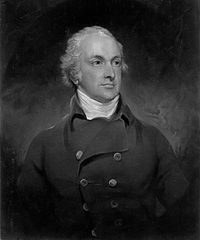
Thomas Pelham
Thomas Pelham 2nd Earl of Chichester was the eldest son of Thomas Pelham, 1st Earl of Chichester, and his wife Anne, daughter of Frederick Meinhardt Frankland. The Right Reverend George Pelham was his younger brother. He was educated at Westminster and Clare College, Cambridge.
Chichester was surveyor-general of ordnance in Lord Rockingham’s 2nd ministry (1782), and Chief Secretary for Ireland in the coalition ministry of 1783 (when he was also appointed to the Privy Council of Ireland). He represented Carrick in the Irish House of Commons from 1783 to 1790 and Clogher from 1795 to 1797. In 1795 he was sworn of the Privy Council and became Irish chief secretary under Pitt’s government, retiring in 1798.
In the latter year he sat briefly for Naas before transferring to Armagh Borough, a seat he held only until the next year. He was Home Secretary from July 1801 to August 1803 under Addington, who made him Chancellor of the Duchy of Lancaster in 1803. Pelham went out of office in 1804, and in the next year succeeded to the earldom. He was joint-Postmaster-General from 1807 to 1823, and for the remaining three years of his life Postmaster-General.
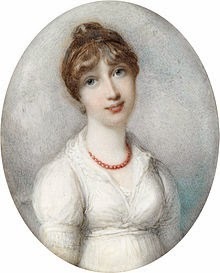
Mary Henrietta Juliana Pelham née Osborne
Lord Chichester married Lady Mary Henrietta Juliana, daughter of Francis Osborne, 5th Duke of Leeds, in 1801. They had three sons and three daughters. Their second son the Hon. Frederick Thomas Pelham was a naval commander while their third son the Right Reverend John Thomas Pelham was Bishop of Norwich. Lord Chichester died in July 1826, aged 70, and was succeeded in his titles by his eldest son, Henry. His daughter Lady Amelia Rose married Major General Sir Joshua Jebb, the Surveyor General of Prisons and designer of Pentonville Prison, the ‘Model Prison’, on 5 September 1854. The Countess of Chichester died in October 1862, aged 86.



